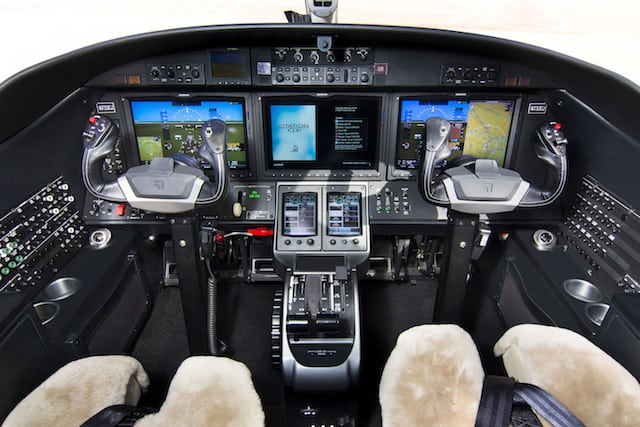
Cessna CJ3 cockpit. Photo courtesy of Textron Aviation
Aircraft equipped with ADS-B Out avionics that meet altitude keeping requirements can obtain reduced vertical separation minimum (RVSM) authorizations if a newly proposed change to that application process with the FAA becomes effective.
Civil aviation authorities first began introducing new RVSM rules in 1997, reducing required vertical separation between aircraft flying above 29,000 feet from a minimum of 2,000 feet to 1,000 feet. The FAA first implemented its current RVSM policy in domestic U.S. airspace in 2005. It then updated the policy again in 2014 to consider operator experience and knowledge in determining the extent of the evaluation required to obtain authorization. In 2016, the agency further modified the application process by eliminating the need for applicants to establish an approved RVSM maintenance program.
According to a new FAA notice of proposed rulemaking (NPRM), the latest proposal has been drafted based on the agency’s response to requests to eliminate the expense of the current RVSM application process for aircraft equipped with ADS-B Out technology.
The FAA proposes to make the rule effective in 2018 and expects the average equipage rate of ADS-B Out aircraft flying in RVSM airspace to reach 95% by 2019 and 100% by Jan. 1, 2020. Some of the aircraft identified by the FAA that would be affected by the rule include the Cessna Citation Mustang, Cessna Citation CJ3 and the Gulfstream IV.
Along with ADS-B Out avionics, aircraft eligible for RVSM operations under the new ADS-B Out provision would also need to be equipped with two operational independent altitude measurement systems and at least one automatic altitude control system that controls the aircraft altitude.
A summary of costs and benefits noted by the FAA in the NPRM states that the agency expects the proposal would result in cost savings totaling $35 million during the first five years of implementation. Cost savings would result primarily from the ability of operators to fly at more fuel-efficient RVSM altitudes.
Additionally, every affected operator of an aircraft equipped with ADS-B would save a total of $1,630 since it would not be required to apply for an RVSM authorization and would not be restricted from RVSM operations while the authorization is under review.
One of the surveillance monitoring capabilities noted by the FAA in the new NPRM states that ADS-B Out systems transmit the “necessary aircraft position information to allow the FAA to perform height-keeping performance monitoring on a continual basis.”
The agency is also planning to share its ADS-B performance concepts and monitoring techniques with the International Civil Aviation Org. Australia, China and Thailand currently use ADS-B Out for RVSM height keeping performance monitoring, and Eurocontrol is also considering its use, according to the FAA.
The FAA is inviting aviation industry comments on the new proposal, but has not yet specified a closing date for comments to be submitted.